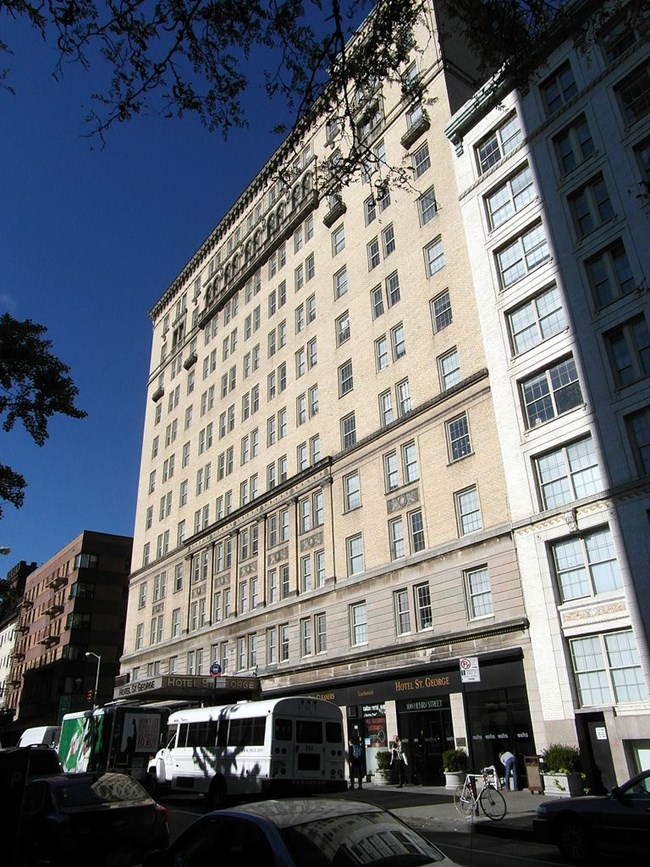Last updated: February 19, 2025
Article
Hotel St. George: Salsa Performance Hub
Hotel St. George is a building in Brooklyn Heights, New York City. Although it is now apartments and student housing shared among various universities in New York City, it was once a lively and important hub for salsa performance and community.

Photo by Reading Tom, Wikimedia Commons, CC BY 2.0.
After it was completed in 1885, the hotel stood as New York's largest hotel for several years. Featuring 2,632 guest rooms, a 120-foot pool, and a vast multicolor-lit ballroom, the St. George Hotel attracted presidents, socialites, and other important figures during its heyday in the 1930s and 40s. These figures include Harry S Truman, Franklin D. Roosevelt, F. Scott Fitzgerald, and Truman Capote. Hotel St. George was also a recognized site for gay residence and cruising up through the 1980s. It was listed in gay publications such as Gaedicker’s Sodom-On-Hudson as a gathering site and frequented by gay figures such as Tennessee Williams in the 40s and Thomas Painter in the 50s. In the decades before 1960, the grand Colorama ballroom was also the site of many other celebrations such as weddings, society gatherings, and other meetings. Among its many varied uses, the hotel served as lodging for troops and their families during World War II. In 1973, the hotel hosted muscle and drag performances in the grand ballroom.
Eventually, New York socialities began preferring gathering spaces in Manhattan as its social scenes became more popular. Army and Navy stations in Brooklyn closed around the same time, causing a substantial part of Hotel St. George’s clientele was lost. These factors meant that Hotel St. George economically suffered. Despite these challenges, Latin music flourished within this space during the 1960s. Young Latinos danced in the Colorama ballroom to many influential performers of salsa including Eddie Palmieri, Larry Harlow, Tito Puente, Celia Cruz, Hector Lavoe, Willie Colón, and many more. Leading promoter Hector Maisonave hosted events on Saturday nights. His massive concerts sometimes featured radio DJs Dick Ricardo Sugar, Symphony Sid, and Polito Vega, who curated dance experiences that brought people together.
The large size of the Colorama ballroom lent itself well to celebrations of community where various salsa performers, promoters, and audiences could come together to enjoy salsa. As Gerson Borrero, a journalist recalling his time at Hotel St. George, recalled: “La manera de que tu conversabas con otra persona era bailando... simplemente tu tienes que sentirlo.” (The way you talked with people was through dancing... you just need to feel it).
The hotel was sold several times in the 1960s and some of it was converted into luxury rentals in the 70s. In the 80s, it was converted into co-operative apartments. Hotel St. George was used by the City to house at-risk individuals including people experiencing homelessness, with HIV or AIDS, and the elderly. A large fire in 1995 consumed much of the original building, which had to be restored.
Hotel St. George is located at 100 Henry St. Brookyln, NY 11201. The Brooklyn Heights Historic District was designated to the National Register of Historic Places in 1968.
This article was researched and written by Hermán Luis Chávez, NCPE Intern, Cultural Resources Office of Interpretation and Education.
Dworin, Caroline. “Trying to Recapture the Glory Days, Up in the Old Hotel.” New York Times. April 5, 2009. https://www.nytimes.com/2009/04/05/nyregion/thecity/05geor.html
Echeverría, Marcos. “Hotel St. George.” Where We Were Safe. 2019. http://whereweweresafe.org/#Hotel._St_George
Harris, Gale. “Hotel St. George.” NYC LGBT Historic Sites Project. 2019. https://www.nyclgbtsites.org/site/st-george-hotel/
“History.” The St. George Tower. https://stgeorgetower.com/history/.
Wiese, Anne Pierson. “Hotel St. George.” Raritan 35, no. 1 (2015): 46.
